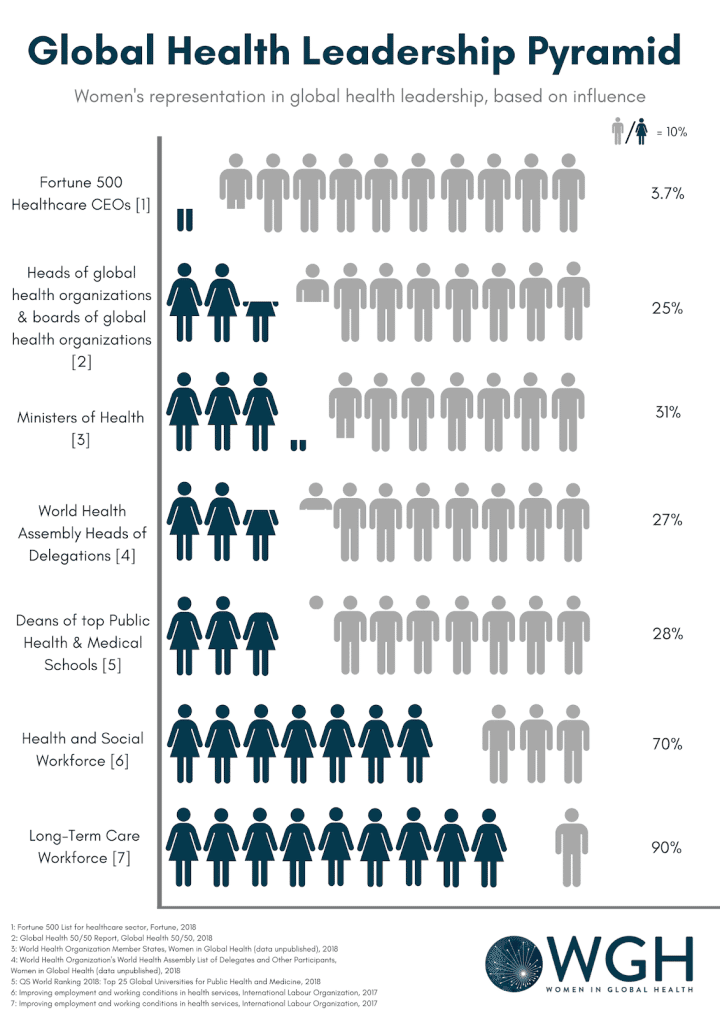Opinion: A new vision for global health leadership
11 May 2018
The Sustainable Development Goals, with universal health coverage at the center, set an ambitious agenda for global health to reach by 2030. But progress continues to be held back by the narrow base from which global health leadership is drawn — and specifically, the widespread exclusion of women from decision-making.
Last year, 400 leaders from 68 countries called for “a new vision for leadership in global health” to address gender inequity and the gender gap in leadership. We propose that gender transformative leadership be used to deliver that vision — both for the advancement of women and to achieve health for all.
Global health: Delivered by women, led by men
Often portrayed as victims in global health, facing sexual harassment, violence, and at times threats to their lives; women form 70 percent of the health and social care workforce. Women are the main drivers of health care delivery and are potentially powerful agents of change. But they hold only around 20 percent of senior posts and are generally segregated into lower status, lower paid, or unpaid sectors.
Despite decades of global targets on gender equality, including SDG 5 on gender equality and empowering all women and girls, the 2017 Global Health 5050 report found that 45 percent of 140 global health organizations surveyed had no commitment to gender equality in their strategies or policies.
Data from Women in Global Health and the global health report have also shone a light on the gender gap in health leadership. Exclusion of women from the majority of health decision-making roles is inequitable, but more than that, it weakens global health since the women workers who know most about health systems have the least say in their design and management.
Women from low- and middle-income countries face the greatest barriers accessing senior posts in their home countries and globally, due to lesser autonomy, gender discrimination, bias, greater vulnerability to harassment and violence, disparities in education and health, and greater burden for domestic and child care. Health policy decisions are not influenced equally by the priorities and experiences of men and women and global health is diminished by lost female ideas, innovation, expertise, and talent.
The roots of gender transformative leadership
Gender transformative leadership is based on concepts of transformative leadership, feminist leadership, and gender transformative approaches. The concept fills critical gaps in current definitions of leadership that are predicated on traits or behaviors, skills, and power relationships between leaders and followers; but have overlooked the question of what leadership looks like.
As the name suggests, there are two main constructs in the definition of gender transformative leadership: “gender” and “transformative leadership.”
Gender transformative leadership is transformative leadership with a gender-inclusive lens. In the global health context, this model addresses the gender inequities in power that undermine health systems’ design and delivery. Gender transformative leadership is driven by the vision of gender equality and women’s rights embodied in international conventions and agreements, including SDG 5, and addresses social and cultural norms, conscious and unconscious bias, and deep-rooted structures of inequality.
Rather than expecting women to “lean in” to professions and organizations that have largely excluded them from leadership and senior roles, gender transformative leadership addresses discrimination, bias, and inequities in the system so women are included on an equal basis to men. The term “gender transformative” can be applied to decision-makers, the institutions they work in, and to the health system itself.
Gender transformative leadership takes an intersectional approach, analyzing how gender intersects with other facets of identity, such as race, disability, sexual orientation, caste, and class, to multiply vulnerability and disadvantage for particular groups.
Additional action is needed to identify and address such multiple, intersectional forms of disadvantage that may affect any gender. In the context of global health, geography is a significant factor for professionals, especially women, from low-income countries, facing structural barriers to participation in global health.
Gender transformative leadership applies to all leaders at each level of health system, from community to global, regardless of their gender. Women in Global Health acknowledges that organizations operate in diverse settings and start from different points so approaches to address gender inequities must be customized to the context. Women in Global Health assumes that a gender transformative approach will include gender parity in leadership but will go beyond gender parity to advance gender equality within organizations and in the work of those organizations, resulting in better global health.
The 10 principles of gender transformative leadership
Gender transformative leadership is predicated on these concrete principles:
1. Grounded in a vision of gender equality and women’s rights.
2. Challenges privilege and imbalances in power to eliminate gendered inefficiencies and rights deficiencies that undermine global health.
3. Is intersectional, addressing social and personal characteristics that intersect with gender — race, ethnicity, etcetera — to create multiple disadvantages. In global health, gender transformative leadership would drive equal participation of all genders from all geographies.
4. Applies to leaders from any gender, not exclusively to women leaders.
5. Covers leadership at all levels in global health from community to global.
6. Recognizes different forms of leadership, such as thought leadership, which are not based on simple hierarchy and people managed.
7. Can be used to describe individuals, institutions, and health systems.
8. Follows the principle of “progressive realization” allowing for different starting points and contexts but prioritizing inclusion of the most marginalized and excluded.
9. Always a “work in progress” since power dynamics are constantly changing.
10. Assumes that gender equality equals smarter global health and that gender transformative leadership is therefore necessary for the achievement of #healthforall.
Gender transformative leaders in global health aim to leave no-one behind in access to health and equally, aim to leave no-one behind in leadership and decision-making.

This article was initially published on the devex.com website
https://www.devex.com/news/opinion-a-new-vision-for-global-health-leadership-93772